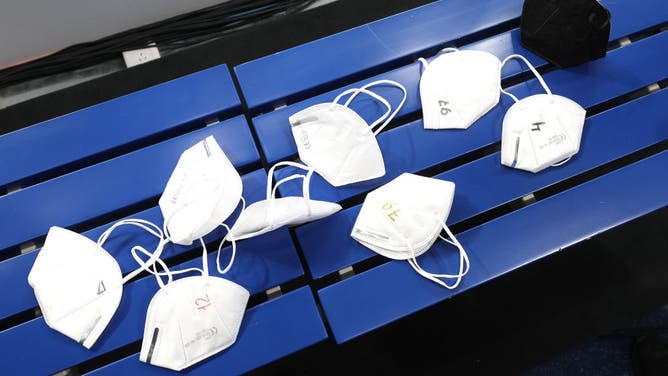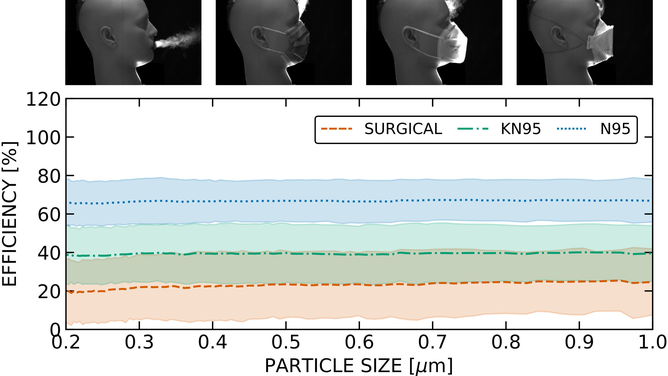Now We Know Why Masks Don't Work
It's been consistently demonstrated since the start of the COVID-19 pandemic that masks do not work.
Despite what "experts" said after flip-flopping in early 2020, they were right the first time: there is no scientific basis to universal masking. Decades of pandemic planning said masks wouldn't work when worn by the general public. Years of research said there was no reason to wear masks during a pandemic. Even Anthony Fauci on 60 Minutes said as much.
Then the pandemic offered an opportunity for real world experimentation. If masks worked, then the endless series of universal mask mandates would stop COVID from spreading. Right? After all, we masked toddlers, often forcing them to tears in the process, forced school children to wear masks for years on end, and enforced discriminatory practices to ensure unmasked individuals were kept out of businesses.
Except the global experiment failed.
Multiple years of mandates did nothing to slow the spread of the virus. Cities like Los Angeles had some of the highest mortality rates in the world, despite restrictive mandates. "Higher quality" masks didn't work in European countries. Every claim "experts" made was conclusively disproven.
And now we know why.

(Photo by Bruce Bennett/Getty Images)
Masks Don't Work Because They Don't Do What They're Supposed To Do
Posted by Emily Burns on Substack, a new study out from researchers at the University of Waterloo in Canada examined the mechanistic question of masks. Not simply whether masks prevent viral spread at a universal level, but the actual physical question of how effective masks are at blocking small particles.
Spoiler alert: not very.
Previous mechanistic studies have claimed to study this issue, though many have reached the conclusion that masks likely provide some benefit to blocking viral particles. Those studies though, may have been measuring the wrong thing. This was referenced by the CDC in a past article in May 2020 reviewing the evidence base for masks.
"Although mechanistic studies support the potential effect of hand hygiene or face masks, evidence from 14 randomized controlled trials of these measures did not support a substantial effect on transmission of laboratory-confirmed influenza," it says.
They also acknowledge that there are "major gaps" in knowledge as to how flu and flu-like viruses spread.
"There are major gaps in our knowledge of the mechanisms of person-to-person transmission of influenza, including the importance of transmission through droplets of different sizes including small particle aerosols, and the potential for droplet and aerosol transmission to occur in different locations and with environmental conditions," the review reads.
They then call for more "high-quality RCTs (randomized controlled trials) of efficacy of face masks" against lab-confirmed influenza. The few RCTs on masks during the pandemic all confirmed they do not work against respiratory viruses. Something that the CDC has studiously ignored.
They continued, saying that the review "did not find evidence" supporting masks to prevent the spread of influenza. Or COVID.
"In this review, we did not find evidence to support a protective effect of personal protective measures or environmental measures in reducing influenza transmission. Although these measures have mechanistic support based on our knowledge of how influenza is transmitted from person to person, randomized trials of hand hygiene and face masks have not demonstrated protection against laboratory-confirmed influenza," the writers added.
And despite this conclusion and acknowledgment of basic science, the CDC and their political partners demanded universal masking. A world-changing policy with no demonstrable benefits.
Regardless, the mechanistic studies that did show a benefit were almost certainly measuring the wrong thing. Until now.
Essentially, previous studies attempting to measure how effective masks are at physically blocking aerosols had looked at larger aerosol particles. Those above 5 microns. But as Emily Burns points out in her analysis, viruses are virtually only found in finer particles under 5 microns.
And those finer aerosols carried significantly more virus, in one instance, nine times as many viral copies, than larger, coarser aerosols.
So the research claiming that masks are an effective barrier against aerosols was conducted on irrelevant sizes. Instead of the smaller, finer aerosols that actually carry virus copies that can infect others.
Because this new study measured the filtration and spread of smaller aerosols, the ones that actually matter, it came up with wildly different results.
All masks, no matter the quality, allowed aerosols in the relevant micron range to escape out around gaps, even when following manufacturer instruction. And because the number of released aerosol is far more than enough to carry the necessary viral load for infection, these results illustrate why masks never actually work in the real world.
"Aided by flow visualization, the analysis of the results shows that the apparent mask filtration efficiency is driven by leakages at the mask-skin interface. The conclusion was reinforced by a comparative analysis with relevant data available from other studies. The obtained statistics provide a range of outward filtration efficiencies that can be expected for an average user who follows manufacturer donning instructions…"
Surgical and KN95 masks filtered less than 40 percent of the important aerosol particle size. N95's were better, but still allowed plenty of aerosol to leak out of gaps.

Regardless of the level of efficacy, each tested mask allowed for thousands more viral copies to spread than required to spread infection. There is no mechanistic way for masks to stop infections, because all of them allow for thousands of virus-containing aerosol particles to leak into the surrounding area.
Reducing the number of aerosols from 10,000 to 8,000 doesn't do much when the necessary number for infection is 100.
This study conclusively demonstrates why masks don't work. They can't. They're not physically capable of completely filtering and restricting the size of aerosol particles that actually transmit the virus from person to person. Which is why areas with mandates performed either the same, or all too often, worse than those without.
They never had the slightest chance of being effective, which is what research and lengthy evidence reviews concluded years ago. People believed they were protected by masking, because experts changed their minds based on wishful thinking, misled the public about the evidence, then refused to admit they were providing answers based on the wrong questions.
Masks don't work, no matter who's wearing them, and no matter how "high quality" they are. They can't.